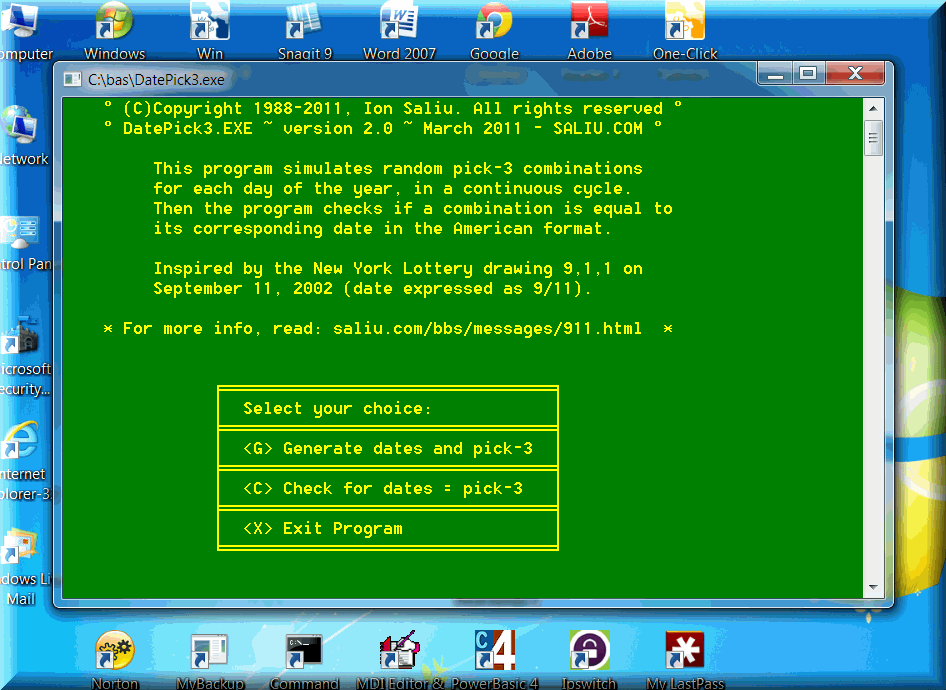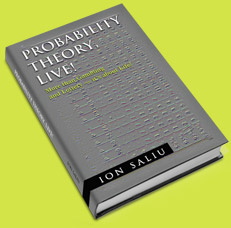
Probability, Odds of New York Lottery Drawing 911 on September 11 (9/11), 2002
A Humane Act of Remembrance But Truth Is Humane Too
By Ion Saliu, ★ Founder of Lottery Mathematics



Written by Ion Saliu on September 26, 2002; updated October 2, 2002 and later.
I was watching television on 9/11, 2002. Many TV programs were dedicated to the tragic event of Tuesday, September 11, 2001. It shall forever be a day of observance for as long as America is. It shall be the day marked as the beginning of the end for religion or the end of the beginning for unbridled Reason. For humanity and no-proof-ever mysticism collided that day as the dinosaur-extinction asteroid collided with the Earth three score and five million years ago.
We were looking as if somebody had just pulled a joke on us! The usually-looking-for-left-wing-trouble Fox News reporters announced that, minutes before, New York lottery drew 9,1,1 as the winning combination in their pick-3 lottery game! The news anchor exclaimed that it was incredible! He was looking in disbelief at the New York lottery website on his laptop.
I was not shocked or hit by anything extraordinary. There is a number of people who wanted to hear me say something about such an extraordinary event. I wanted to say something immediately. I didn't have underpinning data, however. I also knew that the motivation of the 9-1-1 lottery draw was humane in nature. It was never meant to hurt humans, but to bring out the best in humans, albeit by means of childish feelings.
Is it plausible to draw 9,1,1 on September 11 (9/11) in the US? Or, draw '1,1,9' on 11th September in most parts of the world, outside the United States? The question is even more acute if considering that September 11 represents a memorable day in America.
Let's look at reality cool-headedly. There are many who swear by the textbooks of their schools. But they keep the formulae locked-up like in medieval castles. The formulae are kept separated from the real world. They were taught in a religious-like manner that the probability of an event is always the same. That's true. But they ignore another fundamental element (parameter) of probability: degree of certainty.
If the probability of a straight pick-3 lottery combination is 1 in 1000 or 1/1000, the event will repeat till the end of time, they reckon. If the combination 0,0,0 was drawn today, it has the same probability (1/1000) to win tomorrow. And if it wins tomorrow, it has the same likelihood to hit the day after, and the day after, and so on forever... Yet, nobody has witnessed a pick-3 combination hitting more than two consecutive drawings. Why? Because the degree of certainty for other events to take place grows with the increase in the number of trials (the third fundamental element of probability).
The most ... common representation of common sense is looking, sometimes, at something outside our minds: Facts. We are always most satisfied with some evidence we can put our finger on. We are faced here with two events. Each has a specific probability. The events must occur simultaneously. That is, a pick-3 combination must be drawn on and only on a date that can be expressed using the three digits of said combination. If today is January 11, the date can be expressed as 111. Only combination '1,1,1' can satisfy the condition. A combination such as 9,1,1 drawn on 1/11 (January 1st, American date format) is not a success.
There are 365 days in a year. All 365 days (or 366 in leap years) can be expressed as 4-digit numbers. 01/11 or 11/01 as January 1 or 1 January. Several dates cannot be expressed as unique 3-digit numbers: October 01 to December 31. If we express October 1 as 101, the number is not unique; it was already used by January 01. Total dates that can be expressed as 3-digit numbers: 273 (January 01 to September 30).
I thought initially that such a condition can be calculated only and only by the product or multiplication of the two individual probabilities: n1/N1 * n2/N2.
It is not that I want to know the probability of a particular pick-3 combination to hit; e.g. the probability of '9,1,1'. What I want to know is the probability of '9,1,1' to hit on a day that can be expressed as '9/11' (in the US) or '11/9' (in Europe or elsewhere). In this case, the probability of the combined event must be AT MOST 1/1000 * 1/300. Or AT MOST '1 in 300,000'. Or the odds must be AT LEAST '300,000 to 1'.
The assumption was right and wrong! The date is not drawn, it is a given. The date is exactly what it is, not a random event. (In my philosophy, however, nothing is absolutely certain see Fundamental Formula of Gambling FFG). But in this case we are free to assume that the probability of the date is 1 or 100%.)
There would be a totally different case to:
1) guess correctly a date (from 1 to 365; p=1/365) AND _
2) guess correctly a pick-3 combination (from 1 to 1000; p=1/1000).
The probability of the combined event would be 1/365 * 1/1000.
That formula is correct IF we want an exact 3-digit number match its exact date. For example, I am only interested that pick-3 911 is drawn on September 11 (9/11 as an American date). I don't care that also 111 can be drawn on January 11, or 501 drawn on May 1.
We have a different situation, however. We are not interested in just one particular date. We want to calculate the probability for ANY date to match a pick-3 drawing. We consider now ALL pick 3 straight sets that can be expressed as a date. We work out mostly the U.S. date format. This time, dedicated software is an invaluable tool for verification.
I wrote such software, I tested it, I verified it many times and I am convinced of the validity of my theory. Program name: DatePick3 (part of the Bright3, lottery software for pick-3 games).

DatePick3 has two functions:
~ Generate dates in one column lexicographically;
~ Generate pick-3 combinations in the second column randomly.
The dates follow the US format: month/day. The dates start at 101 (January 01) and end at 1231 (December 31). The program does not consider the leap years. The program runs continuously in cycles of 365 days, until the user stops the execution (pressing X or the function key F10). The date-combination lines are saved to disk. The output file can be very large. The file looks like this:
101 093
1231 345
The second function opens the output file and records all occurrences when the date and the pick-3 combination are equal. Thus, only the 911-on-September-11type of occurrences are counted.
I ran DatePick3 lottery software many times. The program generated and checked millions of pick-3 combinations and dates. There are occurrences of date-equal-to-the-combination virtually every year.
The probability of such patterns is not 1/1000; it is closer to 1 in 1337. The difference from regular pick-3 lottery is caused by the dates that can be expressed only as 4-digit numbers. There are 273 dates between 101 and 930 that can be expressed as 3-digit numbers. Therefore 365/273 * 1000 = 1 in 1337.
I checked also the pick-4 drawings against the dates. The new lottery program is DatePick4. It looks clear to me that the probability of ANY pick-4 combination to match its date is 1 in 10,000 exactly like in the regular 4-digit lottery game. The program DatePick4 can generate at least 200,000 date-pick 4 combinations per minute. Let the program run until it generates 1,000,000 lines. Run it several times and calculate the average odds.
The major question still remains. Drawing a pick 3 combination on a very special date such as 9/11 will always lead to controversy. We have no choice but singularize on such rare occasions. It is not that there are 273 pick-3 combinations that match their dates expressed as 3-digit numbers. It is selecting EXACTLY one pick-3 combination on EXACTLY one particular date. The odds of accomplishing that are significantly higher! There are two easy ways to accomplish the feat. Have all the lottery balls in the drawing machine #1 read 9; all the lottery balls in the drawing machine #2 read 1; all the lottery balls in the drawing machine #3 read 1.
Or, repeat the drawing until 9,1,1 comes out! Better still, use precise software. You might have to generate 365,000 lines with the date as the first element and the pick-3 random draw as the 2nd element of the line. DatePick3 is very fast in this regard. But you have to use another software tool to count all occurrences of, say, exactly 911 911. You might not find one single occurrence. But if you generate millions and millions of combinations, you'll certainly notice an average of 1 in 365,000 occurrences of 911 911.
The degree of certainty is even lower much lower IF considering an anniversary or commemoration as well. Say, draw 704 on July 4, 1976 (the Bicentennial of the United States). Simple coincidence cannot explain it. Randomness can't, either. As random as the Universe is, events as such can only be the result of human planning or ordering.
The motivation behind the 9,1,1 drawing was, understandably, plenty humane. Yet, I can't defeat my strong curiosity to know exactly what happened behind the scenes. The Truth is always above anything and anybody or it should be. The New York Lottery Commission should have come out publicly after the 911 drawing on September 11, 2002.
They should have told the truth: The 911 lottery drawing was dedicated to the victims of the 9/11, 2001 tragedy. Of course, the New York Lottery Commission should have also assured that the decision was kept strictly secret; and no member of the commission, family, or friends were informed, let alone win the lottery prize.
Only Randomness is Almighty. Randomness is Great! Randominus vobiscum!
(The chant of rigorous atheism or positivism)
 Read Ion Saliu's first book in print: Probability Theory, Live!
Read Ion Saliu's first book in print: Probability Theory, Live!
~ Founded on valuable mathematical discoveries with a wide range of scientific applications, including probability theory applied to gambling, lottery, software, life, Universe.

Resources in Theory of Probability, Mathematics, Statistics, Combinatorics, Software
See a comprehensive directory of the pages and materials on the subject of theory of probability, mathematics, statistics, combinatorics, plus software.
Of interest:

Home | Search | New Writings | Software | Odds, Generator | Contents | Forums | Sitemap
